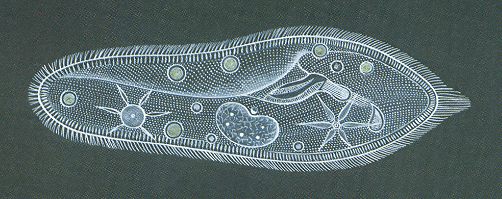
The Conjugation of the Paramecium*
This has nothing
to do with
propagating
The species
is continued
as so many are
(among the smaller creatures)
by fission
(and this species
is very small
next in order to
the amoeba, the beginning one)
The paramecium
achieves, then,
immortality
by dividing
But when
the paramecium
desires renewal
strength another joy
this is what
the paramecium does:
The paramecium
lies down beside
another paramecium
Slowly inexplicably
the exchange
takes place
in which
some bits
of the nucleus of each
are exchanged
for some bits
of the nucleus
of the other
This is called
the conjugation of the paramecium.
to do with
propagating
The species
is continued
as so many are
(among the smaller creatures)
by fission
(and this species
is very small
next in order to
the amoeba, the beginning one)
The paramecium
achieves, then,
immortality
by dividing
But when
the paramecium
desires renewal
strength another joy
this is what
the paramecium does:
The paramecium
lies down beside
another paramecium
Slowly inexplicably
the exchange
takes place
in which
some bits
of the nucleus of each
are exchanged
for some bits
of the nucleus
of the other
This is called
the conjugation of the paramecium.
Muriel Rukeyser
Helle Jorgensen
Whilst on the subject of sea creatures, please follow the links below. . . Helle Jorgensen is a master in the art of crocheting what most of us would consider the impossibly complex. . .
http://hellejorgensen.typepad.com/photos/coral_garden/index.html
http://hellejorgensen.typepad.com/photos/artcraft/index.html (recovered plastic bags become yarn out of which Helle crochets elaborate sea creatures. . . see Echino below)
For more Tuesday Poems, please clink (I mean, click) on the quill. Janis Freegard is this week's editor on the TP hub with Vivienne Plumb's prose poem 128 Abel Street.




Delightful!
ReplyDeleteEven the dictionary-definition has grace: slipper-shape, etc.
Many thanks, dear Claire!
Big smile over here. From the poem to a crocheted (sp?)creature of the sea, which I have yet to tackle with a pencil.
ReplyDeleteImpressive in its detail.
Thank you Claire.
A sexy science poem! Hard to achieve, but beautifully wrought.
ReplyDeleteI love that philosophical flight of fancy near the beginning of Tom Robbins' novel, "Even Cowgirls Get the Blues" when he posits that the very first amoeba is still here today and may be anywhere at this moment in time, even up your nose.
I love this - used to read quite a bit of Muriel Rukeyser, so this is a reminder to pick her up again.
ReplyDeleteclaire, where is the image of the paramecium from?
ReplyDelete(etching? electronmicroscopy?)
i used to draw them in high school, endlessly...
yes, i was a bit odd.
Mim - isn't it an elegant creature? Google reveals clever people who have taken the 'slipper' reference quite to heart and created a range of paramecium footwear. I'd wear a pair, wouldn't you? xo
ReplyDeleteHi Ant! Happy to know you're smiling over there. I'd love to see some of your drawings one day, Ant? (Pretty please?)
ReplyDeleteBen Hur, hello. It is a sexy poem, isn't it. . . ! Not quite as sexy, the consideration that one of the world's oldest critters might be up one of our noses right this very moment?!! The idea makes me want to sneeze. Bless me! And bless you and the masterful Tom Robbins!! Your comment made me chuckle ; )
ReplyDeleteHi Kathleen - lovely to find you here. Thanks for visiting. I'd 'forgotten' (though not really) Muriel Rukeyser for a while, too. She never fails to satisfying and surprise. There's nothing fuzzy-edged about her writing; it's as though she's looking through a hi-def. camera (or, as in this instance, a microscope), her take on things all sharp-focus and clarity.
ReplyDeleteHi Susan, I'm afraid I can't remember where I found this image (would ideally have acknowledged the source). It's been sitting in my draft box for yonks and when I searched through Google images again, it was nowhere to be seen. I imagine it's a drawing - it brings to mind Haeckel's exquisite biological atlases, and could well be one of his. I will have another look.
ReplyDeleteYou were an odd child? That makes two of us. I suspect most of us out here were. . . which says something of us as adults, too, yes? As Marylinn wrote in a recent post, ". . . What is great in us comes from our otherness. It is the compost in which we bloom and thrive. It will carry us past our imagined limitations. All we have to do is scratch it behind its curiously-shaped ears and love it."
Btw, there are people out (t)here making felted paramecium key rings and stuffed toys, which is kind of endearing?!
What happened to your drawings? If you still have them would you consider posting one on TK? xo